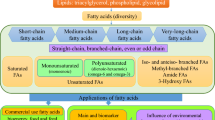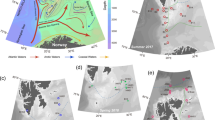Abstract
Structure and functioning of colonial pyrosomes are largely undescribed and their lipid characteristics have received limited attention. The aim of this paper is to fill this gap on one of the dominant species Pyrosoma atlanticum. Lipid content is tightly coupled to size and weight. Lipid composition shows a large dominance of structural polar lipids. Neutral lipids were dominated by sterols with low levels of acylglycerols and free fatty acids. Phospholipids show a dominance of PC with intermediate percentages of PE and DPG. Other constituents (PS, PI, LPC, sphingolipids) were present at lower levels. Fatty acid composition of DAG and TAG showed a dominance of saturated acids (16:0, 14:0), DHA and intermediate levels of MUFA. Phospholipids were dominated by DHA with values exceeding 30% of total FA in all categories except for PI, where lower percentages occurred. Saturated acids were second in abundance with MUFA showing intermediate concentrations. Sterols were dominated by 24-methylcholesta-5,22E-dien-3β-ol with more than 22% of the total sterol. Cholesterol (cholest-5-en-3β-ol) represented only 12 % of the total while 24-methylcholesta-5,24(28)E-dien-3β-ol accounted for 11% of the total sterols. The low levels of triacylglycerols and free fatty acids, coupled with high concentrations of glycolipids and phytoplankton-derived degraded chloropigments, is evidence of a direct link with the digestive activity and substantiate the idea of a high physiological turnover as an alternative to large lipid accumulation. The fatty acid and sterol profiles are consistent with a diverse phytoplankton diet, and a strong contribution of phospholipid classes to energy needs, including locomotion.



Similar content being viewed by others
References
vanSoest RWM (1981) A monograph of the order Pyrosomatida (Tunicata, Thaliacea). J Plankton Res 3:603–631
Bone Q (1998) Locomotion, locomotor muscles and buoyancy. In: Bone Q (ed) The biology of pelagic tunicates. Oxford University Press, Oxford, pp 35–53
Slantchev K, Yalçin F, Ersöz T, Nechev J, Cahs I, Stefanov K, Popov F (2002) Composition of lipophilic extracts of two tunicates. Styela sp. and Phallusia sp. from the eastern Mediterranean. Z Naturforsch 57:534–540
Veracaoundin I, Barnathan G, Gaydou EM, Aknin M (2003) Phospholipid FA from Indian Ocean Tunicates Eudistoma bituminis and Cystodytes violatinctus. Lipids 38:85–88
Reinhardt SB, Van Vleet ES (1986) Lipid composition of twenty two species of Antarctic midwater zooplankton and fish. Mar Biol 91:149–159
Deibel D, Cavaletto JF, Riehl M, Gardner WS (1992) Lipid and lipid class content of the pelagic tunicate Oikopleura vanhoeffeni. Mar Ecol Prog Ser 88:297–302
Pond DW, Sargent JR (1998) Lipid composition of the pelagic tunicate Doiloletta gegenbauri (Tunicata, Thaliacea). J Plankton Res 20:169–174
Phleger CF, Nelson MM, Mooney B, Nichols PD (2000) Lipids of Antarctic salps and their commensal hyperiid amphipods. Polar Biol 23:329–337
Culkin F, Morris RJ (1970) The fatty acid composition of two marine filter-feeders in relation to a phytoplankton diet. Deep Sea Res 17:861–865
Jeffs AG, Nichols PD, Mooney BD, Philipps KL, Phleger CF (2004) Identifying potential prey of the pelagic larvae of the spiny lobster Jasus edwardsii using signature lipids. Comp Biochem Physiol 137B:487–507
Bligh EG, Dyer WJ (1959). A rapid method of total lipid extraction and purification. Canadian Journal of Biochemistry and Physiol 37:911–917
Morrison WR, Smith LM (1964) Preparation of fatty acid methyl esters and dimethylacetals from lipids with boron fluoride-methanol. J Lipid Res 5:600–608
Sokal RR, Rohlf FJ (1981) Biometry. Freeman and Co, NewYork
Gower JC (1987) Introduction to ordination techniques. In: Legendre P, Legendre L (eds) Development in numerical ecology. NATO ASI series G14, pp. 3–64
Pielou EC (1984) The interpretation of ecological data. Wiley-Interscience, New York
Mayzaud P, Chanut JP, Ackman RG (1989) Seasonal changes of the biochemical composition of marine particulate matter with special reference to fatty acid and sterols. Mar Ecol Prog Ser 56:189–204
Lebart L, Morineau A, Piron M (1995) Statistique exploratoire multidimensionnelle. Dunod, Paris
Perissinotto R, Mayzaud P, Nichols PD, Labat J-P (2007) Grazing of Pyrosoma atlanticum (Tunicata, Thaliacea) in the south Indian Ocean. Mar Ecol Prog Ser 330:1–11
Drits AV, Arashkevich EG, Semenova TN (1992) Pyrosoma atlanticum (Tunicata, Thaliacea): grazing impact on phytoplankton standing stock and role in organic carbon flux. J Plankton Res 14:799–809
Lee RF (1974) Lipids of zooplankton from Bute Inlet, British Columbia. J Fish Res Bd Can 31:1577–1582
Morris RJ, McCartney MJ, Schulze-Rönnecke A (1983) Bolinopsis infundibulum biochemical composition in relation to diet. J Exp Mar Biol Ecol 67:149–157
Lee RF (1975) Lipids of Arctic zooplankton. Comp Biochem Physiol 51B:263–266
Falk-Petersen S, Sargent JR, Tande KS (1987) Lipid composition of zooplankton in relation to the sub-arctic food web. Polar Biol 8:115–120
Hagen W (1988) On the significance of lipids in Antarctic zooplankton. Berichte zur Polarforschung 49:1–129 (Can Trans Fish Aquat; Sci., 5458)
Dalsgaard J, St John M, Kattner G, Müller-Navarra D, Hagen W (2003) Fatty acid trophic markers in the pelagic marine environment: a review. Adv Mar Biol 46:225–340
Harbison GR, McAlister VL (1979) The filter-feeding rates and particle retention efficiencies of three species of Cyclosalpa (Tunicata, Thaliacea). Limnol Oceanogr 24:875–892
Makar’eva TN, Grebnev BB, Dmitrenok AS, Stonik VA (1993) Sterol composition of Pyrosoma giganteum. Chem Natural Compounds 28:517–518
Teshima S (1972) Sterol metabolism. Mem Fac Fish Kagoshima University 21:69–147
Volkman JK (1986) A review of sterol markers for marine and terrigenous organic matter. Org Geochem 9:83–99
Mansour MP, Volkman JK, Jackson AE Blackburn SI (1999) The fatty acid and sterol composition of five marine dinoflagellates. J Phycol 35:710–720
Piretti MV, Pagliuca G, Boni L, Pistocchi R, Diamante M, Gazzoti T (1997) Investigation of 4-methyl sterols from cultured dinoflagellate algal strains. J Phycol 33:61–67
Mayzaud P, Albessard E, Cuzin-Roudy J (1998). Changes in lipid composition of the Antarctic krill Euphausia superba in the Indian sector of the Antarctic Ocean. Distribution among organs and sexual maturity stage. Mar Ecol Prog Ser 173:149–162
Mayzaud P, Albessard E, Virtue P, Boutoute M (2000) Environmental constraints on the lipid structure and metabolism of euphausiids: the case of Euphausia superba and Meganyctiphanes norvegica. Can J Fish Aquat Sci 57:91–103
Mayzaud P, Boutoute M, Alonzo F (2003) Lipid composition of the euphausiids Euphausia vallentini and Thysanoessa macrura during the summer in the Indian sector of the Southern ocean. Antarctic Sci 15:463–475
Joseph JD (1979) Lipid composition of marine and estuarine invertebrates: porifera and cnidaria. Prog Lipid Res 18:1–30
Lehninger AL, Nelson DL, Cox MM (1993) Principles of biochemistry. Worth Publishers, New York
Infante JP, Kirwan RC, Brenna JT (1987) High levels of docosahexaenoic acid (22:6n-3)-containing phopholipids in high frequency contraction muscles of hummingbirds and rattlesnakes. Comp Biochem Physiol 130B:291–298
Zachowcki A (1993) Phopholipids in animal eukaryotic membranes: transverse asymmetry and movement. Biochem J 294:1–14
Acknowledgements
We thank the French CNRS, the French Polar Institute (IPEV), the South African NRF and the University of KwaZulu-Natal (Durban, South Africa) for providing funds for this study. Finally, we like to thank the captain, officers and crew of the “RV Marion-Dufresne” for their assistance and cooperation during the ANTARES-4 voyage.
Author information
Authors and Affiliations
Corresponding author
About this article
Cite this article
Mayzaud, P., Boutoute, M., Perissinotto, R. et al. Polar and Neutral Lipid Composition in the Pelagic Tunicate Pyrosoma atlanticum . Lipids 42, 647–657 (2007). https://doi.org/10.1007/s11745-007-3066-0
Received:
Accepted:
Published:
Issue Date:
DOI: https://doi.org/10.1007/s11745-007-3066-0




